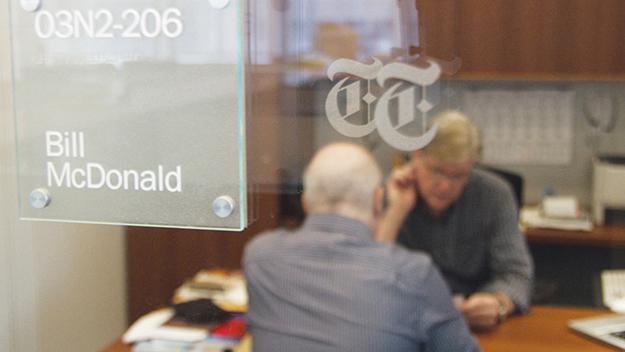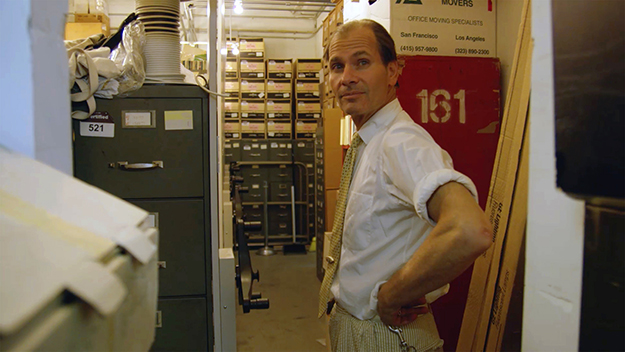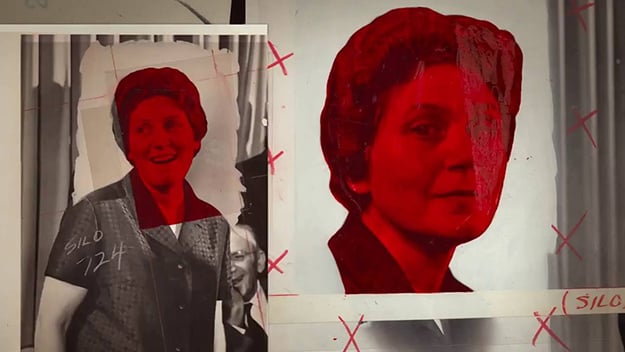Deep Focus: Obit

Vanessa Gould’s brisk, affectionate documentary Obit suggests that obituary writing as practiced by the ace team at The New York Times could be the most imaginative and organic form of journalism in contemporary newspapers. The movie notes that obit writers used to be shunned as verbal undertakers, and that the obit department was often viewed as a dustbin for worn or flaky talents. But readers appreciate the obituary pages of the Times as an oasis of discernment, unpredictability, and evocative writing. Increasingly, it has contained the qualities that make up E.M. Forster’s “two cheers for democracy”: criticism and variety.
A day in the life of the Times obit department becomes Gould’s narrative frame. On December 11, 2014, Bruce Weber strives to encapsulate the groundbreaking significance of JFK’s little-known TV aide William P. Wilson, who succeeded in making his candidate look vigorous and commanding in the first televised presidential debate and thus changed the face of American politics. In a nearby cubicle, Paul Vitello struggles for words to capture the visual comedy of legendary ad-man Dick Rich, who believed strong images were the key to TV commercials, and proved it with campaigns that counterpointed catch-phrases like, “No matter what shape your stomach is in,” for Alka-Seltzer, with unforgettable gags or montages, like a series of midsections that are, to quote from the printed version of Vitello’s copy, “fit and trim or fat and jiggling, a ballerina’s, a hard hat’s, or a fallen boxer’s pressed to the mat.”
Under Gould’s eyes, these writers and their colleagues, including Margalit Fox, William Grimes, and Douglas Martin, and section editor William McDonald, along with his deputy Jack Kadden and assistant Peter Keepnews, go about their normal duties, which include conferring on story length and placement and potential illustrations. They also break off to explain, for example, why every obit contains a clearly sourced confirmation of the subject’s death, usually in the second paragraph. We learn that, based on a false European report, a Times writer once composed an obit for a Russian dancer who was alive in a Manhattan nursing home.

Gould intercuts pieces of interviews she did with the writers in their homes, along with archival footage put together as niftily as Rich did his buff and flabby stomachs. As that elegant, exciting stylist Fox put it in a Times article roughly a year ago, “The resulting images capture not only our subjects in their prime but also the steady, sometimes dubious progress of history and the slow accretion of memory—all topics of the utmost concern to obituary writers.”
Obit grows more lucid and involving as it goes along not simply because it opens up the obit-writer’s sensibilities, but also because it develops a steady internal drive of its own. Insights Gould culls from interviews snap together with the real-life theater she unveils before us. Fox explains that white men have been overrepresented on the Times obituary pages because we’ve only recently entered an era when lives affected by the civil rights and women’s movements would be covered in great numbers. That clicks in our minds with the realization that the two pieces we see taking shape are about politics in 1961 and advertising in the Mad Men era.
The obit writers ponder whether human existence takes on historical significance because of individual free will or the workings of cosmic destiny or some mash-up of talent, luck, and happenstance. The film becomes elating as they master their own existential quandaries in the race to file copy by 6 p.m. The word “deadline” takes on renewed meaning when we see them use the tools at their disposal—deteriorating clips and vintage photos, books grabbed off the internet, and quotes taken by hand—to take the fullest measure of a life, usually in 800 words or less. The deadline is their fate, inhuman and immovable. Everything they do leading up to it is an expression of their self-determination, as they make a series of sophisticated literary and journalistic decisions.

How far can Weber delve into the Nixon-JFK debate without naming the subject of the obituary? Does writing about the commercial brilliance of the man who made Alka-Seltzer funny require Vitello to be just as deft and witty? While they wrestle with these questions, Fox reads work that displays a glorious command of literary devices from onomatopoeia, in an obit about the longest surviving typewriter repairman (“for eight decades, Manson Whitlock kept the 20th century’s ambient music going: the ffft of the roller, the ding of the bell, the decisive zhoop . . . bang of the carriage return, the companionable clack of the keys”), to a kind of bravura understatement, in an obit about an adventurer who traversed oceans in a rowboat (“He crossed the Atlantic because it was there, and the Pacific because it was also there”).
The formality of Gould’s approach both clarifies and distances the material. Except for the odd question about mortality, when we see the writers at home, we view them strictly as artists or professionals; when we go inside the Times, we witness only process, not office byplay. The filmmaker’s reticence contributes to the slightly muffled feeling at the movie’s core. We wonder why these veterans welcome a filmmaker into their midst to record them in the throes of composition. Unfortunately, the answer is found not in the film but in the press kit, where Gould explains that she first contacted the obit department in 2010. She had sent out a news release to major English-language newspapers about the death of a 53-year-old friend of hers, Eric Joisel, an ultra-sophisticated French paper artist, two years after Gould featured him in Between the Folds, her 2008 documentary about origami masters. Only the Times responded, and Fox interviewed her for a “beautiful and fitting obituary” that appreciated “the unique value” of his work.
Why did Gould keep herself out of the movie? It would have been fun to get to know the woman who seems on top of every reference (except the one to Harlem Globetrotters star Meadowlark Lemon). And what more immediate example could Gould give of the craft of the obit writer? It might have been moving to see Gould turn the tables on Fox and her friends, making them the subject of a piece that, like Gould’s other documentary, centers (to quote Fox) “on the life of the mind, the making of art, and the painstaking process by which the two can be combined.”

Obit is still unfailingly refreshing and engrossing. My favorite vignettes feature morgue custodian Jeff Roth, the only one left to track a byzantine filing system for fading images and crumbling copy. One day he ran across a 1922 photo of Dr. Charles Louis Seeger Jr., a musicologist touring the South with his family. Roth made a note of it in his memory. Sure enough, when the man’s eldest son, Pete Seeger, died, the Times used that picture to show a boy who had his folk-singing destiny laid out for him when he was a two-year-old sitting on his father’s knee.
In movies like Brazil, directors used a maze of filing cabinets to denote bureaucratic inhumanity. In Obit, they register as the physical expression of a delightfully complicated mind. The movie as a whole is a salute to a humane art that’s flourished in an overly compartmentalized age.
Michael Sragow is a contributing editor to Film Comment and writes its Deep Focus column. He is a member of the National Society of Film Critics and the Los Angeles Film Critics Association. He also curates “The Moviegoer” at the Library of America website.







